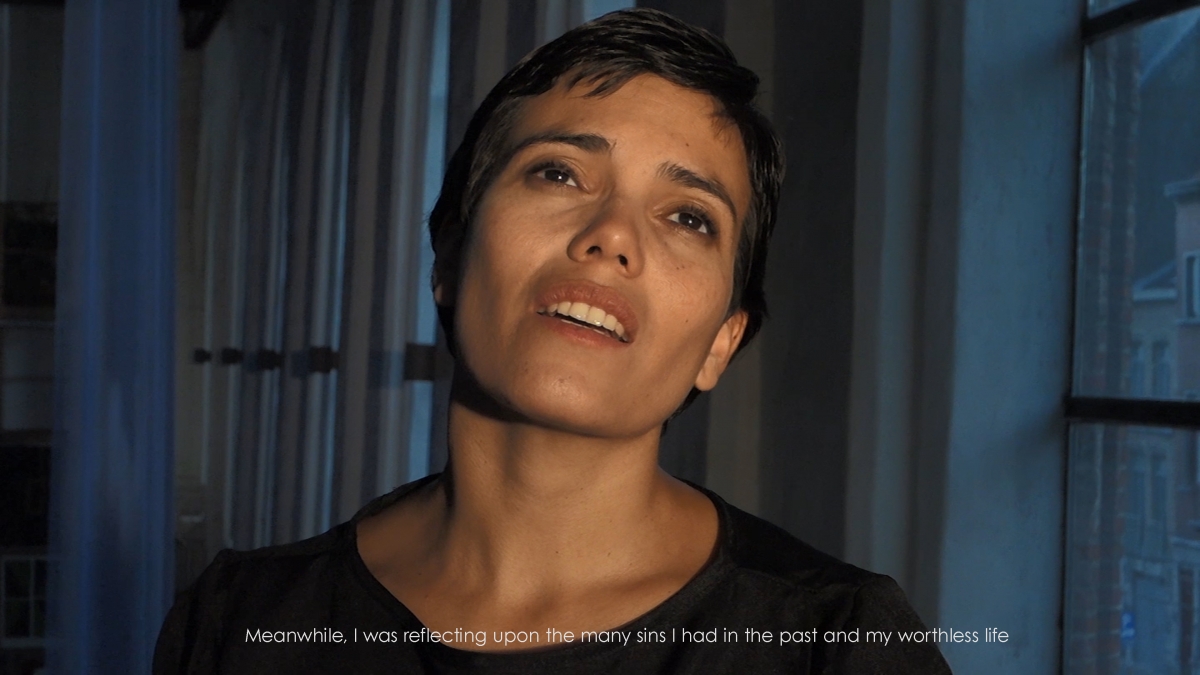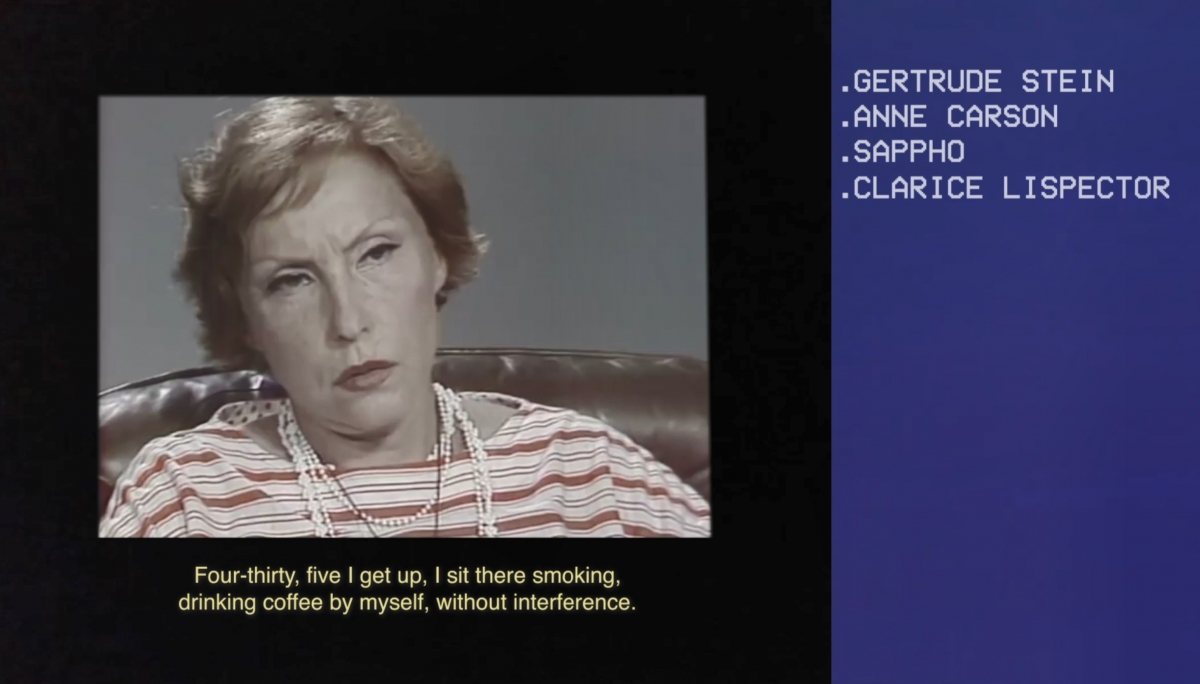There is a common misbelief that the strongest muscle in the human body is the tongue. Anatomically speaking, it is a proven falsehood. Yet with her first extensive solo show in her native Vilnius, the artist Goda Palekaitė proposes that, poetically speaking, it is more than true. The project talks about the power of speaking and writing in relation to the body and sexuality in the context of marginalised history.
In her artistic practice, Palekaitė dives into the liminal space of the psyche, inviting viewers to encounter controversial historical figures in their transgressive states of mind. In her texts, video works, performances and installations, the artist presents futurists from the past who were considered by their contemporaries to be dissidents, heretics or perverts, but who succeeded in breaking through deep-rooted knowledge.
This time, Palekaitė speaks through women’s tongues — historic and contemporary female writers, mystics and saints. It can be seen as her tactic to speak through the voices of others in order to disseminate her own. In The Strongest Muscle in the Human Body is the Tongue, historical accounts are merged with ‘unreliable’ material (or the leftovers of history, such as dreams, rumours and opinions), as well as with fiction, and the artist’s own autobiographical testimonies. Working against the faith in authentic creativity and originality, Palekaitė welcomes historical characters on her inner journeys, as they welcome her on theirs, and so the intimacy with history can emerge.
The new film I Write while Disappearing (17 min) is based on found television interviews which serve for the artist to create a fictional discussion between herself and 14 female writers. French feminists find themselves in conversation with a Brazilian mystic, an Austrian dramatist, a Soviet-Lithuanian romantic, and a number of others, in an intimate sharing of what it means to be a woman and an artist. Meanwhile, the author’s own voice pierces through: ‘If I steal does it mean that I write?’
The work The Blazing World presents, for the first time in a Lithuanian context, Margaret Cavendish, a 17th-century writer and public figure in Baroque England. Today, her novel The Blazing World (1666) is considered to be the first-ever written work of science-fiction. In her writings, Cavendish wildly connects the natural sciences of her day with philosophy, speculative reasoning and fantasy, without complying with any rules, not even grammar. Her work can be read today as feminist and post-humanist, the philosophy that accounts for a world beyond the hierarchy led by anthropos. In the exhibition, Palekaitė presents The Blazing World by translating extracts from it into Lithuanian and attempting to imitate Margaret’s style. The graphic design is created by Jonė Miškinytė.
In her video Biographic Disobedience (15 min), the artist composes a script from the accounts of several Medieval Christian saints. She proposes to perceive these women as proto-feminist writers, even though some of them may have been illiterate. By expressing their extremely intimate, and often erotic, encounters with Jesus, they managed to challenge and revolutionise the position of woman in patriarchal Christian society. The film was created in collaboration with the performer Caterina Mora, the filmmaker Rui Calvo, and the composer Adomas Palekas.
The Strongest Muscle in the Human Body is the Tongue is produced in collaboration with The Institute of Things to Come. In May 2021, it will be presented at Kunsthal Gent in Ghent. It is supported by the Lithuanian Council for Culture, Vilnius City Municipality, Hasselt University, and Fondazione Campagnia di San Paolo.
Special thanks to Antanas Gerlikas, Mykolas Sinkevičius and Adomas Palekas.
Artist: Goda Palekaite
Exhibition title: The Strongest Muscle in the Human Body is the Tongue
Venue: Editorial, Vilnius
Dates: 26.03-30.04.2021
Photography: Ugnius Gelguda, Editorial

Goda Palekaitė, Biographic disobedience. Video, 15 min, 2020.

Goda Palekaitė, still from Biographic Disobedience. Video, 15 min, 2020.

Goda Palekaitė, The Strongest Muscle in the Human Body is the Tongue. Exhibition view at Editorial, Vilnius, 2021.

Goda Palekaitė, The Strongest Muscle in the Human Body is the Tongue. Exhibition view at Editorial, Vilnius, 2021.

Goda Palekaitė, The Strongest Muscle in the Human Body is the Tongue. Exhibition view at Editorial, Vilnius, 2021.

Goda Palekaitė, scenography for video I Write while Disappearing. Script, desk drawer, 2021.

Goda Palekaitė, I Write while Disappearing. Video, 17 min, 2021.

Goda Palekaitė, I Write while Disappearing. Video, 17 min, 2021.

Goda Palekaitė, I Write while Disappearing. Video, 17 min, 2021.

Goda Palekaitė, I Write while Disappearing. Video, 17 min, 2021.

Goda Palekaitė, still from I Write While Disappearing. Video, 17 min, 2021.

Goda Palekaitė, The Blazing World. 2021.

Goda Palekaitė, The Blazing World. 2021.

Goda Palekaitė, The Blazing World. 2021.

Goda Palekaitė, The Blazing World. 2021.

Goda Palekaitė, The Strongest Muscle in the Human Body is the Tongue. Exhibition view at Editorial, Vilnius, 2021.

Goda Palekaitė, First class relic. Wood, glass, bones, 2021.

Goda Palekaitė, First class relic. Wood, glass, bones, 2021.
Goda Palekaitė, excerpt from Biographic Disobedience. Video, 15 min, 2020.
Goda Palekaitė, excerpt from I Write While Disappearing. Video, 17 min, 2021.






























